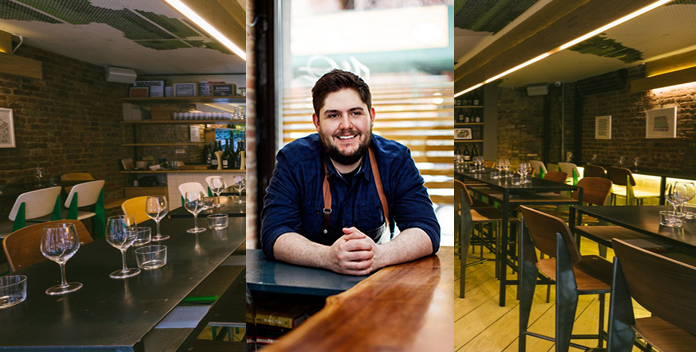Postcard from New York: A Chat with Fabián Von Hauske
The Lower East Side of Manhattan, once populated by immigrant Jews—my grandparents lived there at the turn of the century—was, by the 1970’s, home to Latinos and Asians as well, the typical melting pot of New York. Entrepreneurial proto-hipsters then began to ply their wares at galleries and pop-up eateries. Orchard Street, the main drag, is now host to chic boutiques, shiny new condos and sleek bistros. Contra, the best of the bunch, was inaugurated in 2014 by chefs Fabián Von Hauske and Jeremiah Stone. Wildair, a more casual wine bar, followed. They both offer a style of cooking, pairing odd ingredients, that New York can call its own. Michelin agrees as they awarded Contra a star last year. I caught up with Von Hauske, who was born and raised in Mexico City, on a recent visit to my hometown. Now a dyed-in-the-wool New Yorker, he introduces himself as “FAY-bee-an;” but his heart is still Mexican.
NG: What is the difference between Contra and Wildair FVH: While Contra is a set tasting menu, we want Wildair to be more of a wine bar, something more casual. At Contra, the dishes/flavors are more subtle and thought out. Here it’s like you’re in someone’s home, it’s noisier there’s wine all around, like a party, more casual.
NG: What do you consider yourself: a Mexican chef or a chef who happens to be Mexican? Do you think your “mexicanidad” has anything to do with how you think about food and cooking?
FVH: I consider myself a ‘Mexican’ chef because I’m Mexican. I grew up in a kind of enclosed environment: I went to Catholic school 5 minutes away from my house, I had a middle class family, middle class friends. My father is a creative person even though he is a businessman, so he and my mom brought us to New York and exposed us to things. I wanted to get out of Mexico City, it felt a bit small – for me, I just wanted to see something else. I mean, I’m very proud of being Mexican, but when I was younger I just wanted to get out and be in the world. But as I grow older I miss the flavors of back home and I try to translate that to some of the food we make.
NG: How is what you are cooking similar to what you ate or cooked growing up in Mexico? FVH: I only worked briefly as a cook in Mexico; it was in a little coffee shop – we did like all kinds of foods, prepared foods, I never worked at a Mexican restaurant. The flavor profiles of what I cook are a little similar but I don’t think anything resembles Mexican food at all. I collaborate with my co-chef and partner Jeremiah (Stone) who is of Chinese ancestry. But sometimes I do incorporate Mexican ingredients: spices, chiles—we use a lot of acidity, that’s perhaps how it resembles Mexican food.
NG: How is it different? FVH: It’s different because we put a lot of emphasis on products we can get here – a lot of stuff I didn’t use back home like rhubarb, a lot of roots, such as jerusalem artichoke or parsnip that you don’t see in Mexican cooking. The way we cook is the way Jeremiah and I have learned through the years, eating different places, working in different countries – that’s the difference between Mexican food and what we do.
NG: Do you see a difference in the way the New York public has received your food from how you imagine they would in Mexico City?
FVH: I don’t know how it would be received in Mexico City, I’m really disconnected from there, to be honest. I think we try to do something very personal and very New York here – multi-cultural without being fusion. People are open to new flavors and combinations, maybe more so than in Mexico; that’s the great thing about this city.
NG: In Mexico foreign i.e. non-mexican food done in an ‘authentic’ way, that is, true to how it would be prepared in its native country, is something new, whereas in New York ‘ethnic’ cuisines are as old as the city itself. Are you inspired by the myriad ethnic cuisines that you may have found in NY?
FVH: Yes, especially here on the lower east side where we are surrounded by different ethnicities. There are still a few old eastern European Jewish delis, we’re near Chinatown, we have the Essex market a couple blocks away which is mostly Latino. New York is a melting pot of all these cultures. We try to embrace that and create all these different flavors mixed together. There are a lot of flavor profiles that come from different cultures.
NG: You and your partner are known for pairing unusual ingredients. How do you arrive at your choices of ingredients, given the enormity of the choices in NY?
FVH: We have a very similar approach; sometimes we talk about an ingredient and we see what we can do with it. For example, we might be developing a ceviche type thing and then we say, almost as a joke “what about using blackberry juice ” then all these different ideas come to mind. We both like weird combinations that we try to bring together successfully. We mostly collaborate, although sometimes one of us comes up with a dish and the other tries it and likes it. But everything starts as a conversation.
NG: I realize that you are not very connected with the Mexican gastronomy scene, but from what and who you know (Enrique, Elena etc.) do you have an opinion on what is happening here?
FVH: I think it’s great that the Mexican landscape is becoming so relevant in the conversation. Mexico’s always had a big food culture but in other countries people don’t know why nor understand that Mexican food is much more than tacos and guacamole. It makes me happy to see that these people represent what’s currently going on in Mexico.
NG: And what is your opinion of the Mexican food scene in NY, i.e. Cosme, Fonda, Empellón etc.?
FVH: I think Alex (Stupak of Empellón) is taking his own approach to Mexican food and it’s pretty cool to see that. They’re doing a great job to extrapolate what’s going on in Mexico. It’s unusual because they’re doing it in a very N.Y. way. I think Cosme is a very N.Y. restaurant even if the food’s Mexican. It’s different from Pujol because here the chefs are exposed to different ingredients and products. I’m sure they have to adjust themselves to the American pallette, not necessarily in a way that’s detrimental to Mexican food.
NG: Do you like living in N.Y.? How is it different from living in Mexico City? Do you have any plans to return to Mexico either to work or to visit?
FVH: I’m going soon just to visit, but I would eventually like to do something there, and go more often and try to discover what’s going on. It’s been a long time since I’ve really spent time back home.
NG: Anything you want to tell to the Mexican public who will be reading this?
FHV: I think for Mexicans it is natural to support other people who are doing something Mexican. There are a lot of Mexican people outside of the country who are doing things that are interesting and I think people should support them as well. You don’t have to do something Mexican to be Mexican, if that makes any sense. I think it’s an important part of spreading the culture, the knowledge. It’s good to go to the US and open a restaurant and show people traditional Mexican food, but I think it’s also important to see how your culture can be approached and communicated in a different way. So I would encourage people when they come to NY to check out our places and also see Stupak’s or Olvera’s restaurant; to be open to other ways ways to communicate our culture.
NG: Last but not least, are you worried about the political situation in the U.S.?
FHV: I’m worried about it because I’m a foreigner and owner of a business, and also I have foreign employees on visas in the same situation. We’re concerned with what’s going on politically. It could potentially be disastrous for all of us.






